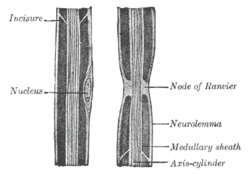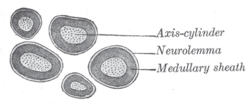Neurilemma: Difference between revisions
No edit summary |
used entry name redid ref |
||
| Line 1: | Line 1: | ||
{{Infobox anatomy |
{{Infobox anatomy |
||
| Name = |
| Name = Neurilemma |
||
| Latin = |
| Latin = |
||
| Image = Gray631.png |
| Image = Gray631.png |
||
| Line 17: | Line 17: | ||
| Code = {{TerminologiaHistologica|2|00|06.1.00002| }} |
| Code = {{TerminologiaHistologica|2|00|06.1.00002| }} |
||
}} |
}} |
||
''' |
'''Neurilemma''' (also known as '''neurolemma''', '''sheath of Schwann''', or '''Schwann's sheath''')<ref name="Dorlands">{{cite book|last1=Albert|first1=Daniel|title=Dorland's illustrated medical dictionary.|date=2012|publisher=Saunders/Elsevier|location=Philadelphia, PA|isbn=9781416062578|page=1262|edition=32nd ed.}}</ref> is the outermost [[cell nucleus|nucleated]] [[cytoplasm]]ic layer of [[Schwann cell]]s (also called neurolemmocytes) that surrounds the [[axon]] of the [[neuron]]. It forms the outermost layer of the [[nerve fiber]] in the [[peripheral nervous system]].<ref name="Marieb" >{{cite book |author1=Elaine N. Marieb |author2=Katja Hoehn | title = Human Anatomy & Physiology (7th Ed.) | publisher = Pearson | pages = 394–5 | year = 2007 | isbn = 0-8053-5909-5}}</ref> |
||
The |
The neurilemma is underlain by the basal lamina (referred to as the medullary sheath in the included illustrations). In the [[central nervous system]], axons are myelinated by [[oligodendrocytes]], thus lack neurolemma. The myelin sheaths of Oligodendrocytes do not have neurolemma because excess [[cytoplasm]] is directed centrally toward the oligodendrocyte cell body. |
||
Neurilemma serves a protective function for peripheral nerve fibers. Damaged nerve fibers may regenerate if the [[perikaryon]] is not damaged and the neurolemma remains intact. The neurolemma forms a regeneration tube through which the growing axon reestablishes its original connection. |
|||
A [[neurilemoma]] is a tumor of the neurilemma.<ref>{{DorlandsDict|six/000071652|neurilemoma}}</ref> |
A [[neurilemoma]] is a tumor of the neurilemma.<ref>{{DorlandsDict|six/000071652|neurilemoma}}</ref> |
||
Revision as of 08:49, 24 February 2018
| Neurilemma | |
|---|---|
 Diagram of longitudinal sections of medullated nerve fibers. | |
 Transverse sections of medullated nerve fibers. | |
| Identifiers | |
| MeSH | D009441 |
| TH | H2.00.06.1.00002 |
| Anatomical terminology | |
Neurilemma (also known as neurolemma, sheath of Schwann, or Schwann's sheath)[1] is the outermost nucleated cytoplasmic layer of Schwann cells (also called neurolemmocytes) that surrounds the axon of the neuron. It forms the outermost layer of the nerve fiber in the peripheral nervous system.[2]
The neurilemma is underlain by the basal lamina (referred to as the medullary sheath in the included illustrations). In the central nervous system, axons are myelinated by oligodendrocytes, thus lack neurolemma. The myelin sheaths of Oligodendrocytes do not have neurolemma because excess cytoplasm is directed centrally toward the oligodendrocyte cell body.
Neurilemma serves a protective function for peripheral nerve fibers. Damaged nerve fibers may regenerate if the perikaryon is not damaged and the neurolemma remains intact. The neurolemma forms a regeneration tube through which the growing axon reestablishes its original connection.
A neurilemoma is a tumor of the neurilemma.[3]
References
- ^ Albert, Daniel (2012). Dorland's illustrated medical dictionary (32nd ed. ed.). Philadelphia, PA: Saunders/Elsevier. p. 1262. ISBN 9781416062578.
{{cite book}}:|edition=has extra text (help) - ^ Elaine N. Marieb; Katja Hoehn (2007). Human Anatomy & Physiology (7th Ed.). Pearson. pp. 394–5. ISBN 0-8053-5909-5.
- ^ "neurilemoma" at Dorland's Medical Dictionary
External links
